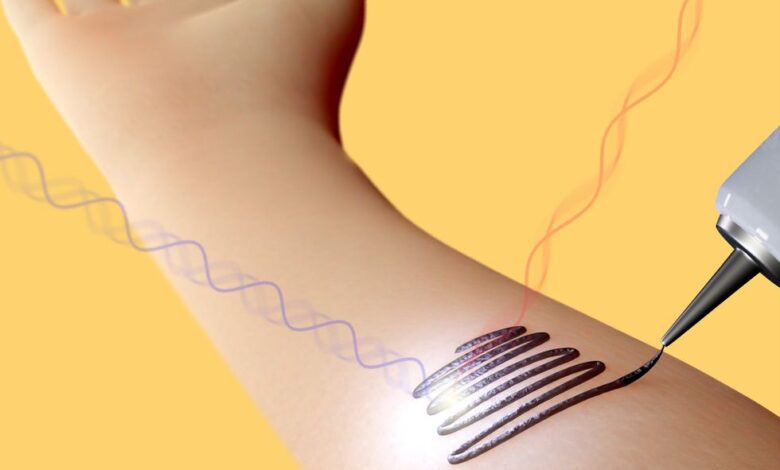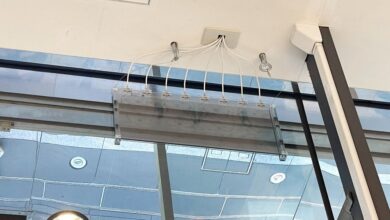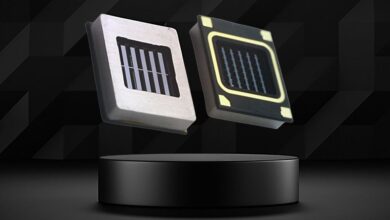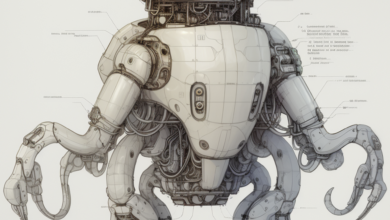New Nano-Tattoos Don’t Need Batteries or Wires

Researchers at two institutions in Istanbul have created nano-tattoos capable of passive wireless communications with nearby devices, without the need for external power sources such as batteries. The advance could lead to numerous bio-sensing technologies that have, up until now, been stymied by relying on a bulky external power source or wired communications.
The backscattering based nano-tattoo sensor (BNTS) tattoos were developed by Kristen D. Belcastro, a lecturer at Yeditepe University, and Onur Ergen, the vice chair of research and development at the Istanbul Technical University’s Department of Electronics and Communication. The tattoos are composed of two inks—a zinc oxide ink containing embedded nanowires atop a graphene aerogel conductive ink. The two inks are painted on to the skin simultaneously via separate needles. Ergen says there is also some aerogel in the ink containing the nanowires, though at a lower ratio than that in the lower layer, and as a result, the two inks bond on contact.
The devices’ wireless communications rely on the creation of electrical signals from piezoelectric activity, made possible as the tattoos change shape, which converts mechanical energy into electrical energy. The tattoos’ wireless networking infrastructure uses a smartphone to bounce signals off the tattoo and receive data, with a broadband modem as a helper device. in the researchers’ work recently published in IEEE Electron Device Letters, the system analyzed range of motion. However, Ergen said there are many more use cases they are exploring.
The ink used for the nano-tattoos is actually two inks in one—a bottom layer containing graphene (black) and a top layer with embedded nanowires (white).Istanbul Technical University/IEEE
“When the painted tag receives the radio frequency (RF) signals, it reflects some of the signals to establish an up-link with the smart phone reader while the smart phone establishes a down-link with the tag,” the researchers wrote in their paper. “From these communication links, the smart phone can continuously monitor the BNTS and process the information using artificial intelligence algorithms.”
Ergen said the communications approach, called ambient backscattering, is similar to RFID, but does not rely on a limited number of allowed frequencies. They successfully received information from the tattoos using a broadband modem at 900 megahertz and 2.45 gigahertz.
The device Belcastro and Ergen have created is similar in principle to other electronic tattoos, and the co-inventor of one such tattoo said the wireless communications link is compelling.
“Having a passive wireless tattoo that you can still access information from is the key here—that caught my attention,” says Dmitry Kireev, an incoming assistant professor of biomedical engineering at the University of Massachusetts-Amherst. As a post-doctoral research associate at the University of Texas, Kireev co-created a graphene tattoo that can accurately measure blood pressure. As thin and flexible as the tattoos are, however, Kireev said the wired connections the tattoos presently require are a considerable obstacle to creating a truly convenient device.
“The challenge with everything we’ve been working on ourselves is interconnect,” Kireev said, “and if there is an approach to do this communication entirely wirelessly, what they are on to here, it’s a very interesting concept.”
Kireev also said the new layered device may help advance the body of communications research around graphene biosensors, which are extremely popular in labs.
“Graphene makes a terrible antenna,” he said. “It’s one layer—it’s not conductive enough. You could make a thicker version, tens of layers or hundreds of layers, but then it’s not really graphene anymore. It’s kind of graphite.”
Nicholas X. Williams, the vice president of technology and product development at device startup X-Cor Therapeutics, co-created an electronic thin film similar to Belcastro’s and Ergen’s device while he was a graduate student at Duke University. Both techniques created functional circuits directly on the skin rather than relying on pre-printed sensors, and Williams said that could bring future customization to the sensor market.
“There are many use cases, and if you manufacture them traditionally you would need a different sensor and pathway for the creation of something for sports medicine as opposed to a biomedical system or for adults versus children,” says Williams. “If you have printed systems, you can generate a file specifically for the use case you need, and that expands the capabilities without needing warehouses full of sensors of various form factors and sizes and intended uses.”
More Healthcare Possibilities, and Beyond
Ergen says that his research on the tattoos is expanding into other aspects of healthcare. One current investigation is how to use the tattoos as wireless EEG sensors. And, though the current version uses the flexing of a body part to generate the energy necessary to receive an ambient signal, Ergen said other approaches might also work. For instance, Ergen and other researchers have previously explored using sweat sensors to collect data.
“However, our recent work, which has not been published yet, enables the analysis of sweat and saliva without the need for a battery, using backscattering technology,” he says. “We expect to publish this work within the next few months.”
The bio-sensing devices are just one part of a larger research portfolio that expands well beyond healthcare for Ergen, who recently received a €1.4 million grant from the European Research Council to explore redesigning batteries through quantum electron engineering. Even the tattoos, which have been stable for more than four months with additional polymer encapsulation, can be deployed in just about any scenario where wireless communication is desired.
“Any surface can be used for this, it’s not limited to the human body,” Ergen said. “You can put it anywhere—cars, for example, in places that are impossible to reach for diagnostics. All new cars have wireless networks. You can paint these somewhere and get the data. You can reach anywhere. If you paint your chair with our sensor you can constantly get information about your sitting position. You can predict if a part might be broken because it starts to give you a weird signal.”
IEEE Spectrum




